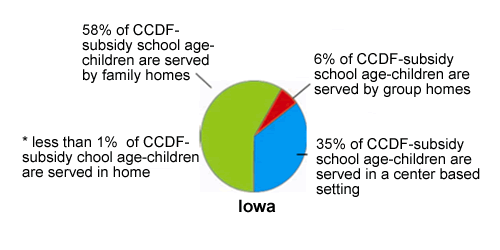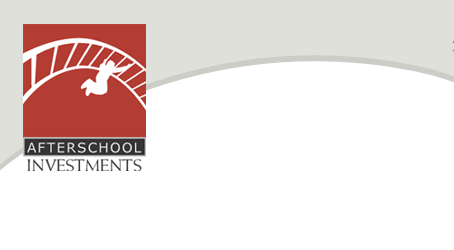|
The Afterschool Investments project has developed profiles for each state to provide a snapshot of the "state of afterschool," as well as an opportunity to compare afterschool activities across the country. This profile provides key data and descriptions of the afterschool landscape, which includes a range of out-of-school time programming that can occur before and after school, on weekends, and during summer months. It is designed to serve as a resource for policymakers, administrators, and providers.
Quick Facts
Demographics
| Total population: |
2,982,085 |
Number of children ages 5-12:
|
306,602 |
| Percent of population: |
10.3% |
Percent of students eligible for free and reduced-price lunch:
|
32.0% |
Percent of K-12 students in Title I "Schoolwide" schools:
|
8.6% |
For more demographic information, visit http://nccic.acf.hhs.gov/statedata/statepro/index.html
Child Care and Development Fund (CCDF)
• CCDF Administrative Overview
Administering agency: |
Iowa Department of Human Services, Bureau of Child Care & Community Srvcs. |
Total FFY06 federal and state CCDF funds: |
$55,899,305 |
FFY06 total federal share: |
$42,052,071 |
FFY06 state MOE plus match: |
$13,847,234 |
FFY06 School Age & Resource and Referral Targeted Funds: |
$158,282 |
FFY06 Tribal CCDF Allocation:
|
$19,358,688 |
FFY05 Total Quality Expenditures: |
$10,162,676 |
Percent of children receiving CCDF subsidies who are ages
5-12: |
43.0% |
• Settings

Where CCDF-Subsidy school age-children are served:
| In a center based setting |
35% |
| By group homes |
6% |
| By family homes |
58% |
| In home |
Less Than 1% |
• Uses of CCDF Targeted Funds and Quality Dollars for Afterschool
"Resource and referral and school-age" targeted funds:
The state Department of Human Services grants these funds to the Iowa School Age Care Association, which partners with local Resource
and Referral agencies. The funding may also be used to provide training, technical assistance, and grants to school-age programs.
Other quality activities:
Data not available.
• Provider Reimbursement Rates
Label assigned by state for school-age rate category: |
School-age |
Maximum rate for center-based school-age category: |
$9.00/half-day |
Notes: A half-day unit is up to 5
hours of care per 24-hour period. |
Standardized monthly center-based school-age rate: |
$180 |
Are separate subsidy rates offered for part-time and full-time care? |
No |
Temporary Assistance for Needy Families (TANF) and Child Care
FFY05 state TANF transfer to CCDF: |
$25,332,746 |
FFY05 TANF direct spending on child care:
|
$2,796 |
Program Licensing and Accreditation Policies
| Are there separate licensing standards governing the care of school-age children? |
No |
Are there specialized requirements for center-based care for school-age children? |
Yes |
Ratio of children to adults in school-age centers: |
5-9 years 15:1; 10 years and over 20:1 |
Number of National AfterSchool Association (NAA) accredited programs:
|
2 |
21st Century Community Learning Centers (21st CCLC)
FY06 state formula grant amount: |
$4,807,715 |
Most recent competition: |
July 2004 |
Applications funded: |
5 |
Total first year grant awards: |
$1,533,038 |
| Fiscal agent type: |
100% school district
0% other |
| Licensing required? |
Yes, for non-school-based sites. |
Return to top
Statewide Initiatives
-
Iowa Afterschool Alliance. The Iowa Afterschool Alliance, a coalition of networks and interest groups with partners from the juvenile justice, education, youth development, and child care sectors, began in 2003 with a three-year C.S. Mott Foundation Grant. The IAA has submitted an application for a new three-year C.S. Mott Foundation Grant to shape a set of comprehensive, cross-agency policies and resources to support afterschool by creating a grassroots-driven, strengths-based Blueprint for Afterschool. The Blueprint for Afterschool will include recommendations on quality programming, policy, funding, availability, state and local implementation, and other key issues. Activities of the Iowa Afterschool Alliance focus on building partnerships that increase the capacity, quality, and sustainability of afterschool programs throughout Iowa.
For more information, see http://www.IowaAfterschoolAlliance.org
-
Iowa Collaboration for Youth Development (ICYD). The Division of Criminal and Juvenile Justice Planning (CJJP) in the Iowa Department of Human Rights in partnership with Iowa Workforce Development created ICYD in 1999 with funds from the HHS Family and Youth Services Bureau Statewide Youth Development Collaboration Project. ICYD represents state and community agencies and organizations promoting positive youth development policy and practice by disseminating best practices, facilitating varied afterschool efforts, and providing a forum for regular networking and information-sharing among state and community partners. ICYD also participates in the ten-state Youth Policy Network of the National Governors Association and the National Crime Prevention Council’s six-state Embedding Prevention in State Policy.
For more information, see: http://www.icyd.org.
-
AmeriCorps State of Promise Program. Coordinated and administered by Iowa State University Extension, 4-H Youth Development, this initiative provides extended learning opportunities for youth by assigning AmeriCorps members to afterschool and summer programs in a number of Iowa school districts. Funded by the Corporation for National and Community Service and the host sites’ extensive network of community partners, the program provides academic assistance, mentoring, and service learning opportunities for over 700 Iowa middle school students.
-
Iowa's Promise. As a result of Iowa's successful work collaborating on youth initiatives, Iowa was selected as one of five states to receive a $20,000 grant from America's Promise. The grant will help facilitate collaboration between existing public and private partnerships, increase awareness about child and youth development issues, and continue to keep children and youth issues a priority for Iowans.
Return to top
Notable Local Initiatives
-
Kids and Company Quality School-Age Child Care. Kids and Company provides child care to school-age children before and after school, on non-school days and throughout the summer for children attending Council Bluffs elementary schools. The Kids and Company program is funded primarily through parent fees. Approximately 18% of the families receive DHS subsidies for their childcare. Kids and Company also seeks out small grants to assist in its financial management. The program participates in the CACFP program.
For more information please visit www.cbkidsandco.org
-
Clinton Community Schools 21st Century Program. Clinton Community Schools is the recipient of two 5-year 21st CCLC grants, one issued in July 2003 and the other in July 2004. The program serves four elementary sites, one middle school site and one alternative high school program. Goals of the program include helping families enhance relationships between home, school and community, improving the academic performance of all students and keeping kids safe after school. Additional activities include enrichment programming, prevention education and adult literacy. Before school programs are held at all elementary sites with all sites providing summer activities including academics.
-
Boys and Girls Club of Central Iowa. Boys and Girls Club of Central Iowa, operating in three sites in the Des Moines inner-city, provides a safe, positive setting for youth between the ages of 5 and 18. Professional staff and engaged volunteers provide youth development programming in Character and Leadership Development, Health and Life Skills, Education and Career Development, Arts, Sports, and Fitness and Recreation. The three sites are open every day after school and all day during school breaks and the summer. The Boys and Girls Club of Central Iowa raises 98% of its operating funds from private sources, and receives a small percentage of funding through Boys and Girls Clubs of America.
Return to top
Statewide Organizations
National AfterSchool Association Affiliate:
Iowa Afterschool Association
1508 8th St SW
Altoona, IA 50009-2319
Phone: 515-967-0788
Statewide Child Care Resource & Referral Network:
Iowa Department of Human Services
Division of Children and Family Services
Child Care Bureau
Hoover State Office Building – 5th Floor
Des Moines, IA 50319
Phone: 515-281-5688
Statewide Afterschool Network:
Iowa Afterschool Alliance
200 10th St., 5th Floor
Des Moines, IA 50309
Phone: 515-243-2000
Web: http://www.IowaAfterschoolAlliance.org
Return to top
Additional Resources
State Child Care Administrators:
http://nccic.acf.hhs.gov/statedata/dirs/display.cfm?title=ccdf
State TANF Contacts:
http://www.acf.hhs.gov/programs/ofa/tanf-dir.htm
21st Century Community Learning Centers Contacts:
http://www.ed.gov/programs/21stcclc/contacts.html
Return to top
Notes and Sources
Demographics
Total population: Annual Estimates of the Population for the United States and States, and for Puerto Rico: April 1, 2000 to July 1, 2006, U.S. Census Bureau.
Number of children ages 5-12: Estimates of the Resident Population by Single-Year of Age and Sex for the United States and States: July 1, 2006, U.S. Census Bureau.
Percent of students eligible for free and reduced-price lunch rate: Numbers and Types of Public Elementary and Secondary Schools from the Common Core of Data: School Year 2005-06. U.S. Department of Education. Washington, DC: National Center for Education Statistics.
Percent of K-12 students in Title I "schoolwide" schools: Numbers and Types of Public Elementary and Secondary Schools from the Common Core of Data: School Year 2005-06. U.S. Department of Education. Washington, DC: National Center for Education Statistics. The federal Title I program provides funding to local school districts and schools with high percentages of poor children to help ensure that all children meet challenging state academic content and student academic achievement standards. Schools enrolling at least 40 percent of students from poor families are eligible to use Title I funds for schoolwide programs that serve all children in the school.
Child Care and Development Fund
The Child Care and Development Fund (CCDF) is the largest federal funding source for child care. States receive a funding allocation determined by formula and have broad flexibility to design programs that provide child care subsidies for low-income children under the age of 13 and to enhance the quality of child care for all children. Federal CCDF funding consists of mandatory, matching, and discretionary funds. Federal law requires that states spend at least 4 percent of their CCDF funds as well as additional targeted funds on activities to improve the quality and availability of child care. CCDF administrative data in this and the following sections is from the U.S. Department of Health & Human Services, Administration for Children and Families, Child Care Bureau, as reported by States, unless otherwise noted.
FFY06 state MOE plus match: In order to receive Federal matching funds, a state must expend Maintenance of Effort funds. Note that this does not capture actual expenditures, only the minimum required to draw down all available federal funds.
FFY06 Tribal CCDF Allocation: Federal CCDF Funds are awarded directly to Federally-recognized Indian Tribes.
FFY05 total quality expenditures: This data includes FY05 and prior year funds expended for quality from each of the CCDF funding streams (mandatory, matching, and discretionary) and expenditures under targeted funds for infant and toddler, school-age care and resource and referral. This figure provides information obtained from state financial reports submitted for FY05.
Uses of CCDF Targeted Funds and Quality Dollars for Afterschool: Portions of CCDF discretionary funds are targeted specifically for resource and referral and school-age child care activities as well as for quality expansion. (These funds are in addition to the required 4 percent minimum quality expenditure.)
Maximum rate for school-age category: Rate listed applies to center-based care; where rates vary by region or county, the rate for the most populated urban area is given.
Standardized monthly school-age rate: Monthly rate for a child, age 8, in care after school during the school year at a center in the most costly district for four hours per day, 20 days per month. Calculated (in the lowest tier of a tiered system) using information from the FY2006-2007. State CCDF Plan, including rate structures, as submitted to the U.S. Department of Health & Human Services, Administration for Children and Families.
Separate subsidy rates for part-time vs. full time and Tiered Reimbursement Rate Systems: U.S. Department of Health and Human Services. Child Care Bureau. Report of State Plans FY2006-2007.
Temporary Assistance for Needy Families (TANF) and Child Care
In addition to spending TANF funds directly on child care, a state may transfer up to 30 percent of its TANF grant to CCDF. Expenditures represent TANF funds spent in FY05 that were awarded in FY05 and prior years. Data from the U.S. Department of Health and Human Services, Administration for Children and Families.
Program Licensing and Accreditation Policies
States with separate school-age licensing standards and states with specialized requirements for child care centers serving school-age children: National Association for Regulatory Administration, 2005 Child Care Licensing Study, available at http://www.nara.affiniscape.com/displaycommon.cfm?an=1&subarticlenbr=104.
Ratio of children to adults in school-age setting: Data from the National Child Care Information Center (NCCIC), available at: http://nccic.acf.hhs.gov.
Number of NAA-accredited programs: Data from the National AfterSchool Association, March 2007, available at: http://www.naaweb.org.
21st Century Community Learning Centers
The No Child Left Behind Act of 2001 converted the 21st Century Community Learning Centers’ authority to a state formula grant. In past years, the U.S. Department of Education made competitive awards directly to school districts. Under the reauthorized law, funds flow to states based on their share of Title I, Part A funds. States use their allocations to make competitive awards to eligible entities. Data from the U.S. Department of Education 21st Century Community Learning Centers Office and the 21st CCLC Profile and Performance Information Collection System.
Return to top
The Child Care Bureau awarded a technical assistance contract to The Finance Project and their partner, the National Governors Association Center for Best Practices, for the Afterschool Investments project. The goals of the Afterschool Investments project include:
- Identifying ways that state and communities are using Child Care and Development Fund (CCDF) subsidy and quality dollars to support out-of-school time programs, and sharing these practices and approaches with other states;
- Identifying administrative and implementation issues related to CCDF investments in out-of-school time programs, and providing information and context (about barriers, problems, opportunities) as well as practical tools that will help CCDF administrators make decisions; and
- Identifying other major programs and sectors that are potential partners for CCDF in supporting out-of-school time programs and providing models, strategies, and tools for coordination with other programs and sectors.
Contact Us:
Email:
afterschool@financeproject.org
Web:
http://nccic.acf.hhs.gov/afterschool/
The Finance Project
1401 New York Avenue, NW
Suite 800
Washington, DC 20005
Phone: 202-587-1000
Web: www.financeproject.org
National Governors Association
Center for Best Practices
444 North Capitol Street, NW
Washington, DC 20001
Phone: 202-624-5300
Web: www.nga.org
The Afterschool Investments project’s State Profiles are designed to provide a comprehensive overview of noteworthy State and local initiatives across the country. Inclusion of an initiative in the Profiles does not represent an endorsement of a particular policy or practice.
|





